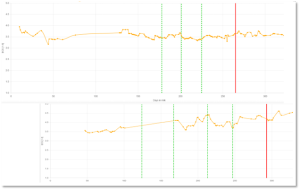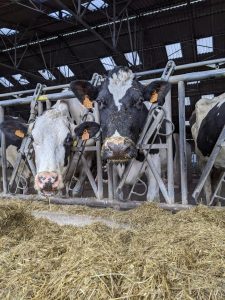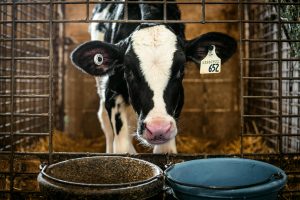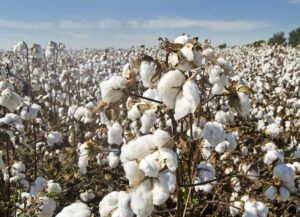Álvaro García
In modern dairy herd management, optimizing reproductive performance and lactation efficiency is not only a matter of animal physiology but a key determinant of economic sustainability. Two key reproductive parameters—days open (the interval between calving and successful conception) and dry period length (the non-lactating interval before the next calving), are interconnected with critical outcomes such as milk yield, fertility, and longevity in the herd. The way these two parameters are managed has direct implications for a dairy farm’s profit margin, primarily through their impact on milk income, culling costs, and reproductive efficiency.
Dairy farmers have always aimed to maintain a 12- to 14-month calving interval, under the assumption that shorter intervals maximize the proportion of lactation spent near peak milk yield. However, as genetic and nutritional advancements have led to cows with greater milk persistency, the marginal economic advantage of shortening the interval between conceptions has declined. Even so, excessively long days open can have cumulative negative effects. Cows that remain open longer are often in late lactation, a period associated with reduced milk production and an increased tendency for over-conditioning. This can impair fertility and elevate the risk of metabolic and reproductive disorders in the following lactation. Prolonged days open have also been linked to lower pregnancy rates, a greater likelihood of involuntary culling, and suboptimal use of a cow’s productive lifespan.
The economic trade-offs of dry period length
The conventional range of 45 to 70 days dry is considered generally optimal, allowing for mammary tissue regeneration and preparation for the next lactation. However, deviations from this range are increasingly common, often driven by delayed conception or early involuntary dry-offs. Extended dry periods—typically the result of late breeding—can lead to cows entering the dry phase with excessive body condition (Garcia. 2024). This increases the likelihood of metabolic disorders and transition-related health problems in the subsequent lactation, which in turn compromises early milk yield, raises culling risk, and reduces overall profitability. These economic losses are compounded by the cost of replacing genetically superior cows and the loss of future milk income. Conversely, overly short dry periods can impair udder recovery and lower colostrum quality, while doing little to address fertility or replacement risks—particularly in cases of shortened gestation, such as for example with twin pregnancies.
Overton and Eicker (2025) reported that longer days open in the previous lactation consistently led to a higher likelihood of culling in the early stages of the subsequent lactation. This trend was particularly evident when cows experienced both very short and overly extended dry periods. Optimal dry periods ranged around 58 days; deviating from this range in either direction increased the risk of early replacement. Additionally, the interaction between the high milk yield in the previous lactation (measured by mature-equivalent 305-day milk yield) and delayed conception reduced the beneficial effect of high production on survivability in the herd.
How about fertility?
Fertility outcomes followed a similar pattern. Cows with shorter days open and standard dry periods were more likely to become pregnant by 90 days in milk during the following lactation. Older cows, those that delivered twins, and those that had clinical mastitis or lameness in the previous lactation all showed impaired reproductive performance. Notably, cows that had higher genomic scores (DWP$) were more likely to avoid early culling and become pregnant early in the next lactation, emphasizing the predictive value of genomics.
Milk production in the first 90 DIM also depended on “previous days open” (i.e. number of days between calving and successful conception in the previous lactation). It reflects how quickly a cow becomes pregnant after calving in the last cycle. And on “previous dry period length” (i.e. the number of days the cow was dry before the current calving). This parameter represents the length of the dry period preceding the most recent lactation.
Cows that conceived earlier and had dry periods close to the industry-recommended length produced more milk. Interestingly, primiparous cows appeared to benefit from slightly longer open periods, possibly due to growth demands. However, extended days open did not provide the same benefits to older cows, where the trend reversed and production declined. This is likely tied to the continued growth demands of primiparous cows after first calving. Unlike mature cows, these younger animals are still allocating nutrients not only to milk production but also to body growth and development. A slightly extended open period allows more time before the physiological demands of gestation resume, giving the cow a better chance to recover body reserves and support continued skeletal and tissue growth. More mature cows have already completed their growth phase, and longer days open do not offer the same developmental benefit. Instead, extended open periods typically mean more time in late lactation, where milk production declines and body condition tend to increase excessively. This can lead to over-conditioning, raising the risk for metabolic issues, impaired fertility, and reduced performance in the next lactation. Thus, while primiparous cows may use a slightly longer open period as a buffer to support growth and future productivity, in older cows, the same extension becomes a liability rather than an advantage.
The two graphs below represent body condition score (BCS) over days in milk (DIM) for two different cows as detected by a 3D Camera in a commercial dairy farm. Top graph: first-lactation primiparous cow, Bottom graph: fourth-lactation multiparous cow
Both graphs include:
- Orange line represents BCS changes
- Green dashed lines represent insemination events.
- Red vertical line indicates positive pregnancy diagnosis.

The primiparous cow shows:
- Stable BCS: After an initial drop early in lactation this first-lactation cow gradually regains condition and maintains relatively stable BCS around 3.5–3.7.
- Earlier conception: The red line (conception) appears around 240 DIM, allowing the cow to be dried off on time and start her next lactation with a traditional dry period.
- Consistent performance: Primiparous cows benefit from slightly longer days open without compromising condition or milk production.
The multiparous cow shows:
- Greater BCS fluctuation: This older cow experiences more volatile shifts in BCS, with notable dips around 180–250 DIM and more dramatic increases later.
- Delayed conception: The red line shows conception occurring much later in lactation (around 290 DIM), leading to extended days open and likely a longer dry period.
- Risk of over-conditioning: After conception, the BCS climbs to over 4.5, above ideal for late gestation. Older cows with delayed conception are at risk of entering the dry period over-conditioned, which increases the likelihood of metabolic disorders, poorer early-lactation performance, and higher replacement risk in the subsequent lactation.
Effective herd management involves maintaining a balance between optimal reproductive timing and dry period length, with considerations for parity, previous health events, and genomic potential. Cows that calve at regular intervals and receive a well-timed dry period are more likely to thrive in their next lactation.
Mismanagement of these parameters can be costly. Studies suggest that each additional 30 days open beyond the optimal window can reduce net income by $90 to $150 per cow annually due to lower milk income, increased culling, and reduced fertility (Cabrera, 2012). Similarly, cows with dry periods outside the optimal 45–70-day range may experience losses of $75 to $125 per cow, depending on their transition health and subsequent lactation performance (Santschi et al., 2011). These numbers underscore the economic importance of reproductive precision and dry period consistency in herd management.
Genomic selection tools like the Dairy Wellness Profit Index (DWP$) can further enhance reproductive decisions. DWP$ combines economically important traits—such as production, fertility, and health—into a single dollar-based value. Cows with higher DWP$ are more likely to remain fertile, productive, and profitable over multiple lactations.
Key takeaways:
- Timely conception improves milk yield, fertility, and reduces replacement costs, especially in older cows.
- Dry periods around 58 days support recovery and transition success; deviations increase risk of culling and metabolic issues.
- First-lactation cows may tolerate longer days open due to ongoing growth, while older cows benefit more from tighter reproductive timing.
- Use genomic tools like DWP$ to guide decisions and enhance lifetime profitability.
© 2025 Dellait Knowledge Center. All Rights Reserved.









